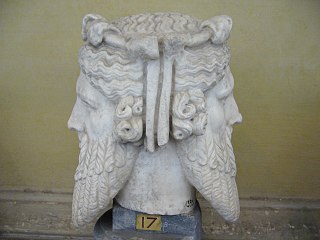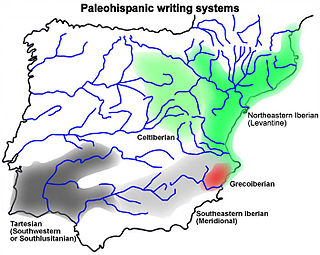Related Research Articles

Saturnalia was an ancient Roman festival in honour of the god Saturn, held on 17 December of the Julian calendar and later expanded with festivities through to 23 December. The holiday was celebrated with a sacrifice at the Temple of Saturn, in the Roman Forum, and a public banquet, followed by private gift-giving, continual partying, and a carnival atmosphere that overturned Roman social norms: gambling was permitted, and masters provided table service for their slaves as it was seen as a time of liberty for both slaves and freedmen alike. A common custom was the election of a "King of the Saturnalia", who would give orders to people, which were to be followed and preside over the merrymaking. The gifts exchanged were usually gag gifts or small figurines made of wax or pottery known as sigillaria. The poet Catullus called it "the best of days".

In ancient Roman religion and myth, Janus is the god of beginnings, gates, transitions, time, duality, doorways, passages, and endings. He is usually depicted as having two faces, since he looks to the future and to the past. It is conventionally thought that the month of January is named for Janus (Ianuarius), but according to ancient Roman farmers' almanacs Juno was the tutelary deity of the month.
Macrobius, fully Macrobius Ambrosius Theodosius, also known as Theodosius, was a Roman provincial who lived during the early fifth century, at the transition of the Roman to the Byzantine Empire, and when Latin was as widespread as Greek among the elite. He is primarily known for his writings, which include the widely copied and read Commentarii in Somnium Scipionis, which was one of the most important sources for Platonism in the Latin West during the Middle Ages, the Saturnalia, a compendium of ancient Roman religious and antiquarian lore, and De differentiis et societatibus graeci latinique verbi, which is now lost.

The Iberians were a set of people that Greek and Roman sources identified with that name in the eastern and southern coasts of the Iberian peninsula, at least from the 6th century BC. The Roman sources also use the term Hispani to refer to the Iberians.

The Celtiberians were a group of Celts and Celticized peoples inhabiting the central-eastern Iberian Peninsula during the final centuries BC. They were explicitly mentioned as being Celts by several classic authors. These tribes spoke the Celtiberian language and wrote it by adapting the Iberian alphabet. The numerous inscriptions that have been discovered, some of them extensive, have allowed scholars to classify the Celtiberian language as a Celtic language, one of the Hispano-Celtic languages that were spoken in pre-Roman and early Roman Iberia. Archaeologically, many elements link Celtiberians with Celts in Central Europe, but also show large differences with both the Hallstatt culture and La Tène culture.
For the Egyptian goddess, see Neith.For the university, see New England Institute of Technology.

Celtiberian or Northeastern Hispano-Celtic is an extinct Indo-European language of the Celtic branch spoken by the Celtiberians in an area of the Iberian Peninsula between the headwaters of the Douro, Tagus, Júcar and Turia rivers and the Ebro river. This language is directly attested in nearly 200 inscriptions dated to the 2nd and 1st centuries BC, mainly in Celtiberian script, a direct adaptation of the northeastern Iberian script, but also in the Latin alphabet. The longest extant Celtiberian inscriptions are those on three Botorrita plaques, bronze plaques from Botorrita near Zaragoza, dating to the early 1st century BC, labelled Botorrita I, III and IV. In the northwest was another Celtic language, Gallaecian, that was closely related to Celtiberian.

The Celtiberian script is a Paleohispanic script that was the main writing system of the Celtiberian language, an extinct Continental Celtic language, which was also occasionally written using the Latin alphabet. This script is a direct adaptation of the northeastern Iberian script, the most frequently used of the Iberian scripts.

The Gallaeci, Callaeci or Callaici were a large Celtic tribal federation who inhabited Gallaecia, the north-western corner of Iberia, a region roughly corresponding to what is now northern Portugal, Galicia, western Asturias and western Castile and León in Spain, before and during the Roman period. They spoke a Q-Celtic language related to Northeastern Hispano-Celtic, usually called Gallaic, Gallaecian, or Northwestern Hispano-Celtic. The region was annexed by the Romans in the time of Caesar Augustus during the Cantabrian Wars, a war which initiated the assimilation of the Gallaeci into Latin culture.

The Lusones were an ancient Celtiberian (Pre-Roman) people of the Iberian Peninsula, who lived in the high Tajuña River valley, northeast of Guadalajara. They were eliminated by the Romans as a significant threat in the end of the 2nd century BC.

The Carpetani were one of the Celtic pre-Roman peoples of the Iberian Peninsula, akin to the Celtiberians, dwelling in the central part of the meseta - the high central upland plain of the Iberian Peninsula.

The Arevaci or Aravaci, were a Celtic people who settled in the Meseta Central of northern Hispania and which dominated most of Celtiberia from the 4th to late 2nd centuries BC. The Vaccaei were their allies.

Saturn was a god in ancient Roman religion, and a character in Roman mythology. He was described as a god of generation, dissolution, plenty, wealth, agriculture, periodic renewal and liberation. Saturn's mythological reign was depicted as a Golden Age of plenty and peace. After the Roman conquest of Greece, he was conflated with the Greek titan Cronus, becoming known as a god of time. Saturn's consort was his sister Ops, with whom he fathered Jupiter, Neptune, Pluto, Juno, Ceres and Vesta.

The Berones were a pre-Roman Celtic people of ancient Spain, although they not were part of the Celtiberians, they lived north of the Celtiberians and close to the Cantabrian Conisci in the middle Ebro region between the Tirón and Alhama rivers.

The Titii or Tithii were a small and obscure Celtiberian people. Whose lands were located along the middle Jalón and upper Tajuña valleys, somewhere between Alhama de Aragón in Zaragoza and Molina de Aragón in Guadalajara provinces.

The Pellendones were an ancient pre-Roman people living on the Iberian Peninsula. From the early 4th century BC they inhabited the region near the source of the river Duero in what today is north-central Spain. The area comprises the north of Soria, the southeast of Burgos and the southwest of La Rioja provinces.

The Belli, also designated Beli or Belaiscos were an ancient pre-Roman Celtic Celtiberian people who lived in the modern Spanish province of Zaragoza from the 3rd Century BC.

The Uraci or Duraci were a little-known Celtic people of pre-Roman Iberia who dwelt to the east of the Vaccaei and the Carpetani, occupying the southern Soria, northern Guadalajara and western Zaragoza provinces since the 4th century BC.

Acci was an ancient inland city of Hispania Tarraconensis, on the borders of Baetica. Under the Romans, and with the Jus Latinum, it was a colony with the full name of Colonia Julia Gemella Accitana. Its coins are numerous, bearing the heads of Augustus, Tiberius, Germanicus, Drusus, and Caligula, and the ensigns of the legions iii. and vi., from which it was colonized by Julius Caesar or Augustus, and from which it derived the name of Gemella. According to Macrobius, Mars was worshipped here with his head surrounded with the sun's rays, under the name of Netos. Such an emblem is seen on the coins. The town became Christian at an early date; the Diocese of Acci was established in 47 AD. The bishop is no longer resident in the uninhabited site, but Acci remains a titular see of the Roman Catholic Church.
References
| This article relating to a European folklore is a stub. You can help Wikipedia by expanding it. |